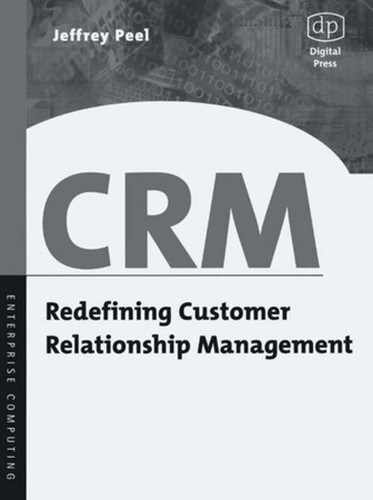0%
114Chapters
0-1Hours read
0kTotal Words
Book Description
In CRM, Jeffrey Peel defines Customer Relationship Management in a radical new way by putting communications at the center. In the past, CRM was mostly about the technology, not about the customer. In this book, Peel talks about a new ethos that is beginning to fundamentally change the way organizations do business. At a technology level, CRM is increasingly about conjoined best-of-breed applications delivered via portal technologies. At a business level, it is beginning to invade traditional territories occupied by brand management or customer support. Peel shows companies how to make the shift to the new paradigm.Table of Contents
- Front cover
- CRMRedefining CustomerRelationship Management
- Copyright
- Contents
- Preface (1/2)
- Preface (2/2)
- Acknowledgments
- Chapter 1 -The New Customer Challenge
- Chapter 2 - CRM Technology and CRM: The Need for a Communication-Centric Approach
- Chapter 3 - The Analyst's View of CRM
- Chapter 4 - The Application Revolution and Its Implications for CRM
- Background
- Myriad definitions
- The portal concept
- The integration: Here and now
- A mix of front ends
- New integration paradigms
- An integration chronology
- The WebSphere story
- A closer look at Web services
- Integration and the implications for CRM
- Defining an integration approach
- A closer look at XML and SOAP and theoperational front-office portal
- Web services and CRM
- Chapter 5 - Analytical CRM
- Chapter 6 - Dot-Com CRM Red Herrings and Introducing CMR (and DCM)
- Chapter 7 - A Role for Marketing-Oriented Ct?dl/l Technologies
- Chapter 8 - Selecting Vendor Solutions
- Chapter 9 - Defining CRM Processes
- Shoddy standards and C RM
- Measurement at the microlevel
- A role for process and outsourcing
- A focus on the four tenets
- A multiple-channel approach
- Describing the customer
- Defining different personas and closingthe loop
- A key role for analytics
- A strategy for channel development
- Establishing electronic processes
- Chapter 10 - A ResearchedApproach to CRM
- Chapter 11 - Conclusion
- Glossary of CRM-Related Terms (1/3)
- Glossary of CRM-Related Terms (2/3)
- Glossary of CRM-Related Terms (3/3)
- Vendo r Directory (1/3)
- Vendo r Directory (2/3)
- Vendo r Directory (3/3)
- About the Author
- Index
